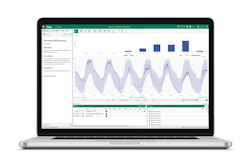With its focus on industrial time series data analytics—derived from historians or other data storage platforms—Seeq’s Workbench software is used in the process industries to search, cleanse, model, and find patterns in data to aid continuous improvement initiatives.
Adding to the Organizer (data visualization and reporting) and Data Lab (analytics expansion with Python) components of Workbench, Seeq has now released the Process Health Solution. Seeq Process Health uses advanced machine learning analytics to deliver a no-code multivariate pattern learning and diagnostic technology to monitor complex manufacturing processes and optimize key performance indicators in near real time for batch and continuous processes.
Allison Buenemann, industry principal at Seeq, says the Process Health Solution is ultimately about workforce empowerment, as it puts machine learning into the hands of operations decision-makers.
“Process Health components are fully integrated with the entire software suite, and users access it via Workbench tools and displays. This means that process data is present immediately following installation,” explains Ashwin Venkat, senior principal applied machine learning scientist at Seeq. “Process Health includes integrated templates for Workbench, Organizer, and Data Lab to capture common views, asset structures, and workflows for process performance and optimization use cases.”
The machine learning advantage
Inclusion of multivariate machine learning (ML) is a key aspect of Seeq Process Health, as it enables additional insights beyond what can be accessed using rules-based methods.
According to Seeq, the multivariate ML aspect of Seeq Process Health provides:
- early detection of events of interest, such as quality deterioration and low/high yields
- real-time insight into contributors
- in-depth cause-and-effect analysis to determine causal factors.
“In addition to users being informed of a process variable being out of range, they also learn why it went out of range—the root cause,” says Venkat. “The Diagnosis component shows users the top contributions and causal factors. This insight empowers users to focus troubleshooting and/or maintenance efforts in the appropriate areas and feel confident about actions they take toward improvement.”
No experience necessary
Because the inputs and results of the ML analytics take the familiar form of Seeq data items, such as the signals and conditions that users regularly interact with, no data science experience is necessary to apply ML in Process Health or other Seeq tools.
“An engineer can assert what is ‘normal’ or ‘target’ behavior with capsules and conditions using their own process knowledge,” says Venkat. “If they do not have an idea to start with, they can request detection of anything anomalous in their current view, assess the contribution rankings and diagnostic causal map, and start digging in.”
Venkat adds that, for those with ML experience, Process Health comes with advanced settings and options that provide greater control and transparency for better human-in-the-loop engagement. “The templates for Workbench, Organizer, and Data Lab also accelerate workflow assembly and deployment so that users and teams can jump right into their discoveries and decisions, creating value quickly,” Venkat says.
Oil and gas application
Williams, a supplier of oil and natural gas, is using Seeq Process Health to accelerate its transition from a reactive to a proactive process monitoring approach.
“Seeq Process Health enabled our team to switch from a rules-based approach, which was difficult to implement and maintain at scale, to an engineer-friendly and transparent, multivariate machine learning approach,” says Oscar Lewis, a senior process operations leader and technical specialist at Williams. “This identified various process upsets, generating significant savings for our large gas gathering operations.”
Explaining how multivariate ML simplifies the monitoring and diagnostics process compared to a rules-based approach in applications such as those used by Williams Company, Venkat says, “Even where reliable univariate rules can be established and monitored, it can be tedious to identify, implement, and maintain them. Additionally, there is often the added complexity of layering multiple univariate rules over each other. This becomes especially onerous when similar systems are monitored, but the univariate limits for monitoring are slightly different for each rule on each system. Then, when layering the possible and likely interactivity of those multiple systems, each with numerous variables being monitored and maintained, it becomes a complex effort with less accurate results.”
Speaking specifically about multivariate ML application for diagnostics, Venkat says, “identifying when one event occurring is affiliated with another is straightforward, but this does not always yield an accurate causal diagnosis. Contribution metrics and correlation analysis illuminate some additional multivariate understanding. The Diagnosis component of Seeq ML drives insights a step further with causal understanding for truly impactful corrective actions.”
Leaders relevant to this article:



